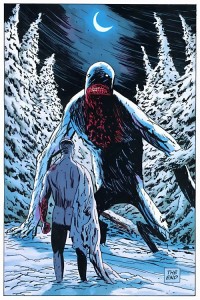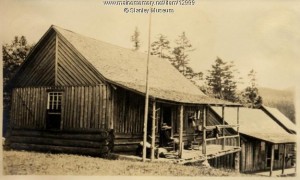Thirteen full moons appear during each year. We have just lived through the “Snow Moon” as taught by the Wabanaki people.
The “Snow Moon” usually brings the heaviest snow falls and coldest temperatures. Wildlife hunkers down to keep warm and save energy. Moving through the woods over deep powdery snow to hunt becomes very difficult. Hence, this time has also been called the “Hunger Moon” and “Starvation Moon.”
The Snow Moon of 2015 turned out to be an extra cold one, and one that lets us fully see how the Wabanaki legends have been used to pass along their hard earned knowledge about living in Maine. For thousands of years the Wabanaki people have used storytelling and spiritual legends to educate their youth and guide their activities in dealing with nature’s challenges.
Each moon has its own Wabanaki spirit, and the spirit for the snow moon is a harsh one. Known either as the chenoo, the giwakwa, or the kiwakwa, you should avoid it no matter what. The word “kiwakwa” means “going about in the woods.” If you don’t want to see one of these monsters, then stay out of the woods during the winter.
And what a monster they are. A “Wendigo,” as this monster is also called in addition to its other Wabanaki names – “Keewaqu” or “Kiwakwa” – is an ice giant, complete with bulging eyes, a mouth full of jagged teeth and a heart of pure ice. They could move around in a whirlwind form hunting for human beings. They are always hungry, and their scream will kill any human who hears it. Entering the woods alone at this time of year makes you most vulnerable to being killed and eaten by this spirit. Safety only comes from trekking with a companion.
This ancient lesson, brought to us by the Wabanaki, is this: Winter can be very deadly. Do not travel into the woods alone. It is safest to travel with a companion.
Behind that wisdom, of course, is our modern knowledge that hypothermia (lowered body temperature) is the number one killer for all outdoor activities. Joseph Conrad’s novel “To Build a Fire” is founded in this reality. Another reality, built into the Wabanaki teaching, is that when alone you will not realize that you are being affected by hypothermia. Your mental faculties are reduced. Therefore, the Wabanaki wisdom says to travel with a companion.
Bringing this to full relevance are two situations from the recent “Snow Moon” in Maine. In one tragic instance, a solo hiker succumbed and died from hypothermia. Perhaps the Wabanaki spirit caught up to the hiker. In a second situation, two fifteen year old boys were able to survive a frigid night by finding shelter and building a fire – or did they survive because the Wabanaki spirit would not attack two persons at once.
Only the spirit world knows for sure.



